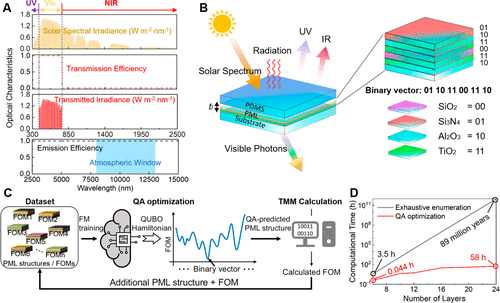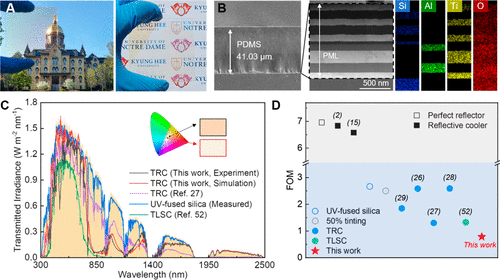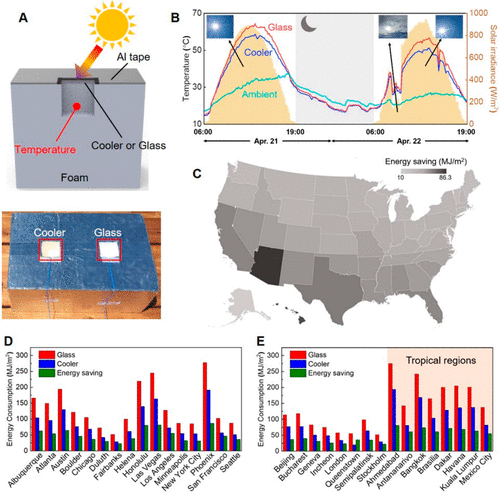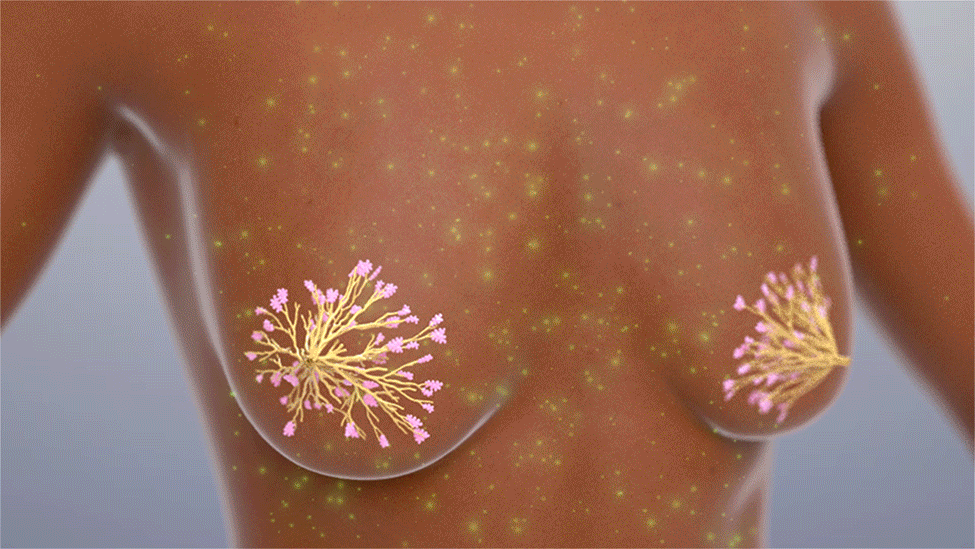Transparent window coating can actively cool buildings without using energy
[Nov. 16, 2022: JD Shavit, The Brighter Side of News]

This window film (held in fingers at top left) keeps rooms bright and cool by allowing visible light to pass in while reflecting invisible infrared and ultraviolet sunlight and radiating heat into outer space. (CREDIT: ACS Energy Letters)
As climate change intensifies summer heat, demand is growing for technologies to cool buildings. Now, researchers report in ACS Energy Letters that they have used advanced computing technology and artificial intelligence to design a transparent window coating that could lower the temperature inside buildings, without expending a single watt of energy.
Studies have estimated that cooling accounts for about 15% of global energy consumption. That demand could be lowered with a window coating that could block the sun’s ultraviolet and near-infrared light — the parts of the solar spectrum that typically pass through glass to heat an enclosed room.
Energy use could be reduced even further if the coating radiates heat from the window’s surface at a wavelength that passes through the atmosphere into outer space. However, it’s difficult to design materials that can meet these criteria simultaneously and can also transmit visible light, meaning they don’t interfere with the view. Eungkyu Lee, Tengfei Luo and colleagues set out to design a “transparent radiative cooler” (TRC) that could do just that.
The team constructed computer models of TRCs consisting of alternating thin layers of common materials like silicon dioxide, silicon nitride, aluminum oxide or titanium dioxide on a glass base, topped with a film of polydimethylsiloxane. They optimized the type, order and combination of layers using an iterative approach guided by machine learning and quantum computing, which stores data using subatomic particles.
Related Stories
This computing method carries out optimization faster and better than conventional computers because it can efficiently test all possible combinations in a fraction of a second. This produced a coating design that, when fabricated, beat the performance of conventionally designed TRCs in addition to one of the best commercial heat-reduction glasses on the market.
In hot, dry cities, the researchers say, the optimized TRC could potentially reduce cooling energy consumption by 31% compared with conventional windows. In the solar spectrum, an ideal TRC is expected to perfectly block ultraviolet (UV) and near-infrared (NIR) photons to minimize optical heating of the enclosed space, as these wavelength regimes contribute ∼50% of the total solar irradiance.
In the meantime, it should allow visible photons to pass through with maximal transmission efficiency to enable a clear field of vision. Furthermore, the TRC should have high emission efficiency in the mid/long-wavelength infrared (M/LWIR) regime to achieve optimal radiative cooling performance via the AW.

TRC concept and the QA-assisted active learning scheme. (A) The solar spectrum (air mass 1.5 global), the transmission efficiency, the resultant transmitted irradiance, and the emission efficiency of an ideal TRC in relevant wavelength regimes. The blue shade presents the AW. (CREDIT: ACS Energy Letters)
It has been demonstrated that emitters with unity emission efficiency across the whole M/LWIR regime can be more beneficial than AW-selective emitters for radiative cooling.
In recent years, there have been several material systems proposed for TRCs, such as stacked multilayers of hydrogenated amorphous Si and SiO2; SiO2 micropillars fabricated on ZnO/Ag/ZnO films; SiO2 nanoparticles dispersed in polydimethylsiloxane (PDMS) films; (28) and stacked layers of metal oxide, glass, polymer and hydrogel.

Experimental demonstration of the QA-designed TRC. Pictures showing the homogeneous optical transparency of the fabricated TRC. The Notre Dame main building image (left) was taken at the University of Notre Dame, and the logos (right) are obtained from university official websites. (CREDIT: ACS Energy Letters)
However, their designs are mainly based on conventional domain-knowledge-driven design strategies, and their performances are far from that of the ideal TRC.
Restimated the benefit of the TRC as a potential window material by calculating the energy it can save annually for a standard office with two windows in the U.S. using EnergyPlus.

Field test and energy saving simulation using our designed TRC as a window material. Schematic and photograph of the experimental setup simulating an insulated environment with a window using our designed TRC and reference glass. (CREDIT: ACS Energy Letters)
The average annual energy saving over the surveyed U.S. cities is 50 MJ/m2 if the TRC is used as the window material. In cities with hot and dry weather (e.g., Phoenix), the TRC can potentially save ∼86.3 MJ/m2 per year, which is 31.1% of the cooling energy consumption when conventional windows are used.
The same calculations have also been performed for selected major cities worldwide. All locations will benefit from the proposed TRC as window materials to save cooling energy, and such a saving can be very significant in tropical regions.
Researchers further note that their findings could be applied to other applications, since TRCs could also be used on car and truck windows. In addition, the group’s quantum computing-enabled optimization technique could be used to design other types of composite materials.
For more science news stories check out our New Innovations section at The Brighter Side of News.
Note: Materials provided above by The Brighter Side of News. Content may be edited for style and length.
Like these kind of feel good stories? Get the Brighter Side of News' newsletter.




